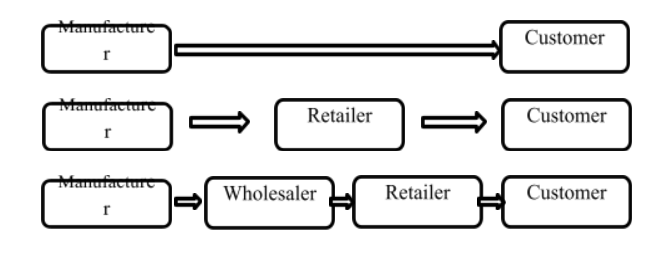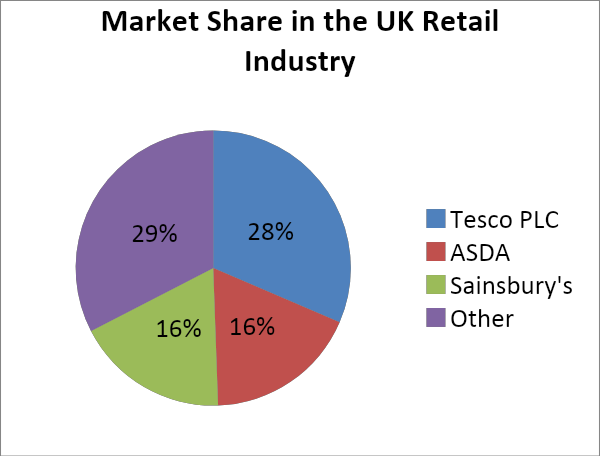Introduction
Retailing organisations sell products and services to the ultimate users or consumers. The retail industry is enormously influential in the UK economy because approximately 2.5 million people are employed in this sector. However, the contribution of the wholesaler is decreasing in the hand of some major retailers of the country(Berman and Evans, 2007). In this paper, I will discuss and analyse different aspects of the retailing sector in the UK, including their structure & organisation, distribution system, sales techniques and competitive factors, etc. I have selected Tesco PLC to scrutinise more deeply different aspects of retailing.
LO1 (1): Know the structure of the retail industry
P1 (1.1): Describe the structure and organisation of the retail sector
The structure and organisation of the retail sector in the UK are becoming more and more complex over the years. The retail industry in the UK has achieved more diversity by introducing different types of stores and location(Cox, Brittain and Cox, 2004). The structure and organisation of the retail sector depend on size and profitability. Below is an illustration of the system and organisation of the retail industry in the UK:
- Types of retailers:
Types | Criteria | Example |
Department Stores | Separate department for a range of goods | Mark & Spencer |
Multiple Chains | Similar branch shops of a single company | McDonald’s |
Independents | Small stores up to three | Boxpark |
Supermarkets | Grocery Store with a wide variety of goods | Tesco PLC, ASDA |
Specialist Outlets | The product range is Particular | Kiddicare |
Table 1.1: Types of retailers, their criteria, and example
- Physical & Online stores: Physical & online stores are a combination of technology and physical resources. Customers can order through the company’s website and get the products delivered to the home.
- Emerging Stores: There are two types of emerging stores. One of them is a shopping village which is a collection of stores. Another kind of emerging store is teleshopping which sells their products through TV.
- Clicks & Bricks: Customers can reserve their wanted products using their online service and buy the products from their shop later.
D1 (1.1.1): Evaluate the distribution systems in delivering goods and services of Tesco PLC
Tesco PLC has almost 1300 supermarkets and convenience stores throughout the UK(Tesco plc, 2016). So the distribution system in delivering products and services is crucial for the company. Below is the illustration of the effectiveness of the distribution system in providing goods and services:
Responsiveness to the customers’ demands: The logistic managers of Tesco PLC are very efficient in maintaining a stock of the stores according to customers demand. The buying habits of customers also depend on seasons. The company has considered these factors to minimise wastage (Kent and Omar, 2003).
Distribution Cost: Tesco PLC has created a well-established distribution network that requires less time and resources and, therefore, less costly in delivering goods and services.
Domestic & International suppliers: The Company has both domestic and international suppliers to have a wide range of products in stock. The company’s distribution systems are very efficient to minimise the damage of goods purchased from global suppliers (Berman and Evans, 2007).
Intermediaries: In most cases, Tesco PLC purchases goods directly from the manufacturer. So the distribution systems of the company have no intermediaries. Therefore, the distribution systems of the company are quicker and less costly.
P2 (1.2): Explain the process of distributing goods through different channels from the manufacturer to the customer
The structure and organisation of a retailer determine distributing goods through different channels from the manufacturer to the customers(UK retail briefing, 2008). Consequently, the distribution process can vary regarding goods and manufacturers perspectives.

The manufacturer can directly sell their products to the customers. But in most cases, they can sell their products through retailers and wholesalers. In addition, some wholesalers and retailers can use their labelling and packaging to establish their branding (Varley and Rafiq, 2004).
M1 (1.2.1): Compare the function of formats and locations in retailing
In the UK, different formats and locations of retailing have developed over the 100 years to diversify their operation to attain a competitive advantage. Formats of retailing include retail parks, factory outlets, superstores, etc. The functions of these retail stores depend on the destination. The different forms in retailing give the customers a wide range of product choice (ConsumerAffairs, 2016).
The location-based retailing includes urban and brownfield, out-of-town locations. These types of retail stores allow specialised and small retailers to flourish. However, location-based retailing stores have a less broad range of product choice for the customers.
LO2 (2): Understand the role of retailing in the distribution of goods and services
P3 (2.1): Explain how focusing on the customer by providing good customer service is essential to retailing
The retailing sector provides service to the end-users of the products and services. Therefore, good customer service is the core of their activities. Good customer service makes the customers valued and influences them to stay longer in the store. Below is a discussion on the importance of providing good customer service in retailing:
- Significance: Customer loyalty is a very crucial factor in the competitive environment. A retailer can gain customers’ loyalty by delivering real value in quality, price, and service. In addition, better focusing on the customer by providing better customer service can give a retailer lifetime customer value.
- Identification: Customers can differentiate based on the customer service of the retailers. So having better customer service facilities gives a retailer a competitive advantage over other retailers.
- Publicity: A customer with a positive experience of a retailer’s customer service will have the possibility of sharing with three or two people about the incident. Conversely, a customer can share a bad customer experience with up to 20 people (ConsumerAffairs, 2016)
- Function: Excellent customer services enable a retailer to do repeated business with the customer. Therefore, it gives the company more profits from more sales. The cost of retaining a customer is less than acquiring a customer.
- Prevention & Solution: Better customer service can solve the issues and complaints of the customers easily and quickly.
D2 (2.1.1): Assess the impact of different sales techniques and customer service in Tesco PLC
Tesco PLC has a 28% market share in the UK retail industry which is well over its competitors. The company has achieved this market share with the help of its excellent sales and customer service techniques. Using deals and customer service, they can understand the customers to create the best possible offer. They can focus on the customers more efficiently and effectively using their sales and customer service techniques. Tesco has introduced “Clubcard” to make the shopping experience of the customers more exhilarating. The company prefers relationship marketing rather than transactional marketing (Retail-week.com, 2016). Therefore, the company can achieve more lifetime value for customers. Tesco PLC has IOS and Android base apps that enable busy customers to access the company website from anywhere to make the shopping process easier(Tesco plc, 2016).

LO3 (3): Understand the sales and service functions in retailing
P4 (3.1): The competitive factors in the retail environment of Tesco PLC
The retail environment in which Tesco PLC operates its business is hugely competitive. The major competitors of Tesco PLC are ASDA, Sainsbury’s, and Morrison regarding market share. Lidl, Farm Foods, Aldi are also taking market share in the UK. PESTLE analysis and Porter’s Five Forces Can be the competitive factors in the retail environment of Tesco PLC (Retail-week.com, 2016).
PESTEL analysis:
Political | The company has an operation in 14 different countries. Therefore, the company has to maintain various local legislations and political factors. |
Economic | Though the current financial situation of the UK customers is comfortable, they are more miniature purchasing high price goods. |
Social | The UK customers are more aware of health issues and want various products to range other than foods. |
Technological | As the UK customers are more comfortable with using different kinds of technology, the retailers in the UK have introduced sophisticated technology in their stores. |
Environmental | Environmental concern is prevalent in the UK. So the retail industries are trying to minimise the production of wastage and use of extra resources. |
Legal | The food retailing commission of the UK has introduced some laws to ensure standard prices of products and services. |
Table 3.1: Tesco PLC’s PESTEL analysis of the competitive factors in the retail environment
Porter’s five forces model:
Bargaining powers of the buyers | In the UK retail sectors, the bargaining power of buyers is very high because of many alternatives. |
Bargaining power of the suppliers | Tesco PLC has a better negotiation with its suppliers to get the lowest price. |
The threat of new entry | The threat of new entry is shallow in the UK retailing sector because major retailers have captured almost 80% of market shares. |
Threat of substitute | The threat of substitute is low because Tesco is providing every kind of goods at a low price |
The intensity of competitive rivalry | The intensity of competitive rivalry is very high between the major retailers in the UK. |
Table 3.2: Tesco PLC’s porter’s five forces model
LO4 (4): Know how the retail sector responds to internal and external change
M2 (4.1.1): Compare the methods used to distribute products and services
The distribution methods for products and services can vary significantly regarding their sector. For example, the food retailer depends on domestic manufacture. Typically, the manufacturer supplies the products directly to the retailer. Therefore, the lead time for the distribution of food products is concise because intermediaries have fewer activities in the channel(Gilbert, 2003). In addition, the distribution channel has a capacity for frozen to keep the products fresh.
On the other hand, clothing retailers depend on manufacturers and suppliers. The lead time for the distribution channel of clothing products is longer because more intermediaries are active in the distribution channel. So the clothing retailers are less responsive to the change of demand of the customers.
M3: Explain how sales techniques and customer service have developed in retail organisations
Retail organisations have adopted sales techniques and customer service based on their structure and organisation. Retailers have developed different systems and organisations to adopt other sales techniques and better customer service facilities. For example, department stores maintain separate departments for each type of product. Supermarkets offer a wide range of products. Retailers also provide product information and expert sales assistance for complex items (Retail-week.com, 2016).
Conclusion
At the end of this paper, I can say that the retail industry in the UK is becoming more complex and diversified in recent years. In the beginning part of this paper, I have discussed different structures and organisation of the retail industry. In the second part of this paper, I have analysed the importance of focusing on the customer in this industry. I have also studied the competitive factors that exist in the retail environment of Tesco PLC in the third part of this paper. Finally, in the last piece of this paper, I have compared different distribution methods and developed sales and customer service techniques in retail organisations.
References & Bibliography
- Berman, B. and Evans, J. (2007). Retail management. Upper Saddle River, NJ: Pearson/Prentice Hall.
- Kent, T. and Omar, O. (2003). Retailing. Houndmills, Basingstoke, Hampshire: Palgrave Macmillan.
- Varley, R. and Rafiq, M. (2004). Principles of retail management. Basingstoke: Palgrave.
- UK retail briefing. (2008). London: Mintel International Group.
- Gilbert, D. (2003). Retail marketing management. Harlow: Financial Times/ Prentice Hall.
- Tesco plc. (2016). Tesco plc. [online] Available at: http://www.tescoplc.com/ [Accessed 12 Apr. 2016].
- ConsumerAffairs. (2016). ConsumerAffairs.com: Knowledge is Power! Consumer news, reviews, complaints, resources, safety recalls. [online] Available at: http://ConsumerAffairs.com [Accessed 16 Apr. 2016].
- Retail-week.com. (2016). Latest data, video and analysis. [online] Available at: http://www.retail-week.com/analysis [Accessed 16 Apr. 2016].





